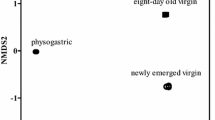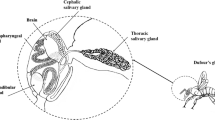Abstract
Using a simple two-choice bioassay and video analysis of individual locomotory tracks, it was determined that a preference for young-bee hosts over old-bee hosts in female honeybee tracheal mites,Acarapis woodi (Rennie), is chemically mediated. When presented with a choice of cuticular extracts from 5-day-old and <1-day-old adult bees, mites showed a significant preference for the young-bee extract in three of four bee colony sources. This discrimination was due apparently to a greater positive response elicited by the young-bee extract rather than a deterrent effect of old-bee extract, as the extract of old bees evoked a significantly higher response than a hexane control. A bioassay of silica-gel fractions of young-bee extract indicated that cuticular hydrocarbons alone were responsible for tracheal mite response. Further fractionation of a hydrocarbon fraction by argentation chromatography demonstrated that both saturated and unsaturated hydrocarbons were involved in the mite response, but when presented in opposition, mites showed a stronger response to the saturated than to the unsaturated components. Mites placed in zones treated with cuticular extract of young bees exhibited higher angular velocities than those placed on hexane, causing them to remain in the extract-treated zones for extended periods. These results point to a possible control strategy whereby migration of tracheal mites to young-bee hosts could be disrupted by artificially altering the chemical profile of the honeybee cuticle.
Similar content being viewed by others
References
Bailey, L. 1958. The epidemiology of the infestation of the honeybee,Apis mellifera L., by the tracheal mite,Acarapis woodi Rennie and the mortality of infested bees.Parasitology 48:493–506.
Bailey, L. 1963. Infectious Diseases of the Honey Bee. Land Books, London. 176 pp.
Bailey, L. 1989. Some notes onAcarapis woodi (Rennie).Am. Bee J. 129:543–545.
Delfinado-Baker, M. 1988. The tracheal mite of honey bees: A crisis in beekeeping, pp. 493–497,in G.R. Needham, R.E. Page, Jr., M. Delfinado-Baker, and C.E. Bowman (eds.). Africanized Honey Bees and Bee Mites. Ellis Horwood, Chichester. 572 pp.
Delfinado-Baker, M., andBaker, E.W. 1982. Notes on honey bee mites of the genusAcarapis Hirst (Acari: Tarsonemidae).Int. J. Acarol. 8(4):211–226.
Francis, B.R., Blanton, W.E., Littlefield, J.L., andNunamaker, R.A. 1989. Hydrocarbons of the cuticle and hemolymph of the adult honey bee (Hymenoptera: Apidae).Ann. Entomol. Soc. Am. 82(4):486–494.
Gary, N.E., andPage, R.E., Jr. 1987. Phenotypic variation in susceptibility of honey bees,Apis mellifera, to infestation by tracheal mites,Acarapis woodi. Exp. Appl. Acarol. 3:291–305.
Gary, N.E., andPage, R.E., Jr. 1988. Factors that affect the infestation of worker honey bees by tracheal mites (Acarapis woodi), pp. 506–511,in G.R. Needham, R.E. Page, Jr., M. Delfinado-Baker, andC.E. Bowman (eds.). Africanized Honey Bees and Bee Mites. Ellis Horwood, Chichester. 572 pp.
Giordani, G. 1977. Facts about acarine mites, pp. 459–467,in C.Meletinov(ed.). Proceedings, XXVIth International Congress on Apiculture.
Hirschfelder, H., andSachs, H. 1952. Recent research on the acarine mite.Bee World 33:201–209.
Howard, R. W., andBlomquist, G. J. 1982. Chemical ecology and biochemistry of insect hydrocarbons.Anna. Rev. Entomol. 27:149–172.
Hunter, P.E., andRosario, R.M.T. 1988. Associations of Mesostigmata with other arthropods.Annu. Rev. Entomol. 33:393–417.
Kjer, D.M., Ragsdale, D.W., andFurgala, B. 1989a. A retrospective and prospective overview of the honey bee tracheal mite,Acarapis woodi R.Am. Bee J. 129:25–28.
Kjer, D.M., Ragsdale, D.W., andFurgala, B. 1989b. A retrospective and prospective overview of the honey bee tracheal mite,Acarapis woodi R.Am. Bee J. 129:112–115.
Krantz, G.W. 1978. A Manual of Acarology, 2nd ed. Oregon State University Bookstores, Corvallis. pp. 27–29.
Le Conte, Y., Arnold, G., Trouiller, J., Masson, C., Chappe, B., andOurisson, G. 1989. Attraction of the parasitic miteVarroa to the drone larvae of honey bees by simple aliphatic esters.Science 245(4918):638–639.
Lee, D.C. 1963. The susceptibility of honey bees of different ages to infestation byAcarapis woodi (Rennie).J. Insect Pathol. 5:11–15.
Morgenthaler, O. 1931. An acarine disease experimental apiary in the Bernese Lake district and some of the results obtained there.Bee World. 12:8–10.
Royce, L.A., Krantz, G.W., Ibay, L.A., andBurgett, D.M. 1988. Some observations on the biology and behavior ofAcarapis woodi andAcarapis dorsalis in Oregon, pp. 498–505,in G.R. Needham, R.E. Page, Jr., M. Delfinado-Baker, andC.E. Bowman (eds.). Africanized Honey Bees and Bee Mites. Ellis Horwood, Chichester. 572 pp.
Smith, A.W. 1990. Population dynamics and chemical ecology of the honey bee tracheal mite,Acarapis woodi (Acari: Tarsonemidae) in Ohio. PhD dissertation. The Ohio State University, Columbus, Ohio.
Smith, A.W., andNeedham, G.R. 1988. A new technique for the rapid removal of tracheal mites from honey bees for biological studies and diagnosis, pp. 530–534,in G.R. Needham, R.E. Page, Jr., M. Delfinado-Baker, andC.E. Bowman (eds.). Africanized Honey Bees and Bee Mites. Ellis Horwood, Chichester. 572 pp.
Smith, A.W., Needham, G.R., andPage, R.E., Jr. 1987. A method for the detection and study of live honey bee tracheal mites (Acarapis woodi Rennie).Am. Bee J. 127:433–436.
Wilson, E.O. 1971. The Insect Societies. Harvard University Press, Cambridge, Massachusetts.
Author information
Authors and Affiliations
Rights and permissions
About this article
Cite this article
Phelan, P.L., Smith, A.W. & Needham, G.R. Mediation of host selection by cuticular hydrocarbons in the honeybee tracheal MiteAcarapis woodi (Rennie). J Chem Ecol 17, 463–473 (1991). https://doi.org/10.1007/BF00994345
Received:
Accepted:
Issue Date:
DOI: https://doi.org/10.1007/BF00994345




